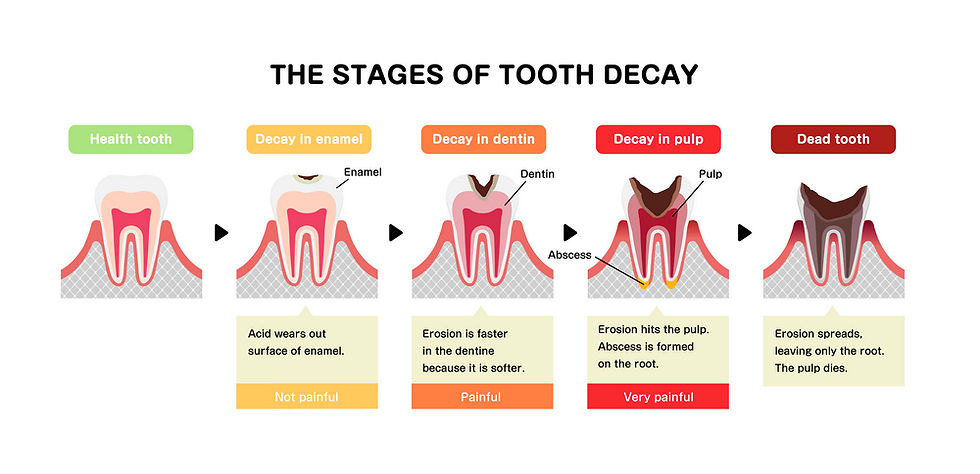The Progression of Dental Decay: Why Early Detection Matters
- Admin
- Mar 14
- 2 min read
Tooth decay is one of the most common dental concerns, affecting people of all ages. What may start as a small, painless issue can quickly escalate into a serious dental problem requiring extensive treatment. Understanding how dental decay progresses and why early detection is crucial can help you maintain a healthy smile and avoid unnecessary discomfort and expense.

How Tooth Decay Starts
Tooth decay begins when plaque—a sticky film of bacteria—accumulates on the teeth. Plaque forms when sugars and starches from food interact with bacteria in the mouth. If not removed through proper brushing and flossing, plaque produces acids that gradually weaken tooth enamel in a process called demineralisation. Over time, small cavities (dental caries) develop as the enamel breaks down.
The Stages of Tooth Decay
Enamel Demineralisation – The earliest stage involves the loss of minerals from the enamel, often appearing as white spots on the teeth.
Enamel Decay – The enamel continues to erode, forming a small cavity. At this stage, there may be little to no discomfort.
Dentin Decay – If left untreated, the cavity deepens into the dentin, the layer beneath the enamel. At this stage, sensitivity to hot, cold, and sweet foods often develops.
Pulp Infection – Decay that reaches the pulp (the tooth’s inner tissue containing nerves and blood vessels) causes severe pain and may lead to an abscess.
Abscess and Tooth Loss – If the infection spreads, it can cause significant swelling, severe pain, and potential tooth loss.

The Risks of Delaying Treatment
Ignoring early signs of decay can lead to serious complications, including:
The need for root canal treatment due to deep infection.
Tooth loss, requiring dental implants or bridges.
Increased treatment costs for complex restorative work.
Severe pain and infections that can affect overall health.
How Early Detection Saves Money, Preserves Teeth, and Prevents Pain
The earlier tooth decay is detected, the easier and more affordable it is to treat. Small cavities can often be repaired with simple fillings, while advanced decay may require crowns, root canals, or even extractions. Early intervention helps preserve your natural teeth, preventing the need for extensive dental work and reducing discomfort in the long run.
Advanced Technology at William Place Dental Aesthetics
At William Place Dental Aesthetics in Bow, East London, we use cutting-edge technology to enhance diagnostic accuracy and ensure no signs of decay go unnoticed. One of the most advanced tools we utilise is Pearl AI Second Opinion, an AI-powered system that assists in analysing X-rays with remarkable precision. This technology provides an additional layer of confidence, helping our dentists detect even the earliest stages of decay before they become major concerns.

Why Regular Check-ups Are Essential
Routine dental check-ups play a key role in preventing decay from progressing. Our comprehensive examinations allow us to spot early signs of cavities and other dental issues before they become severe. With professional cleanings, preventative treatments, and expert advice, you can keep your teeth strong and healthy for years to come.
How to Book
You can book your appointment directly on our website: www.williamplacedental.co.uk
When booking, please:
Select “NEW” or "EXISTING" under Patient Type
Choose “PRIVATE” under Insurance
From the Reason drop-down menu, select Comprehensive Oral Health Assessment (£54) or OFF-PEAK Comprehensive Oral Health Assessment (£35)

















Comentários